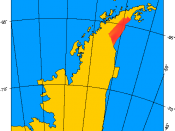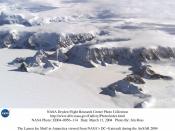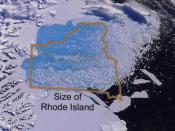Two ice shelves on the Antarctic known as the Larsen B and the Wilkins are in "full retreat" and have lost nearly 3,000 square kilometers if their total area in the last year according to scientists in Colorado and the United Kingdom.
Researchers at the University of Colorado at Boulder's National Snow and Ice Data Center and the British Antarctic Survey attribute the retreats to a regional warming trend. The trend has caused the annual melt season to increase by two to three weeks over the last twenty years. Satellite photos monitored by NSIDC show that the Larsen B ice shelf has continued to crumble after an initial small retreat in the spring of 1998. In a series of events that began in November 1998, an additional 1,714 square kilometers if shelf area caved away, according to Research Associate Ted Scambos of CU-Boulder's NSIDC.
On the opposite side of the peninsula, the Wilkins Ice Shelf retreated nearly 1,100 square kilometers in early March of last year.
Scientists looking at weather satellite imagery at that time suspected a breakup was underway and had their suspicions confirmed by radar satellite images. According to Scambos, the radar images showed a large area of completely shattered ice, indicating an ice front 35 kilometers back from its previous extent. Also according to Scambos, the sudden appearance of thousands of small icebergs suggests that the shelves are essentially broken up in place and then flushed out by storms or currents afterward.
The British Antarctic Survey scientists had predicted one of these retreats, using computer models to demonstrate that the Larsen B was nearing its stability limit. With the small breakup observed last spring, the shelf had already retreated too far to continue to be supported by adjacent islands and shorelines. Scientists at both institutes expected the...



GOOd JoB
It's very easy to notice that this was well researched before written. all it needs is a better finishing touch. overall, a well prepared paper.
1 out of 1 people found this comment useful.